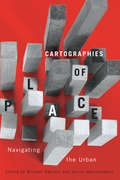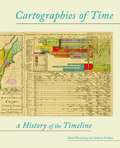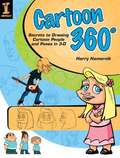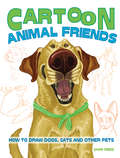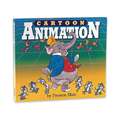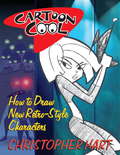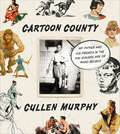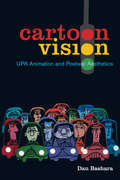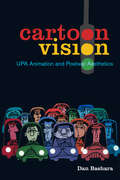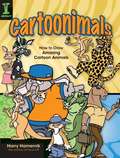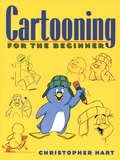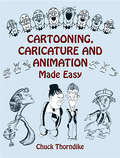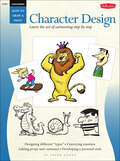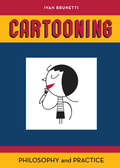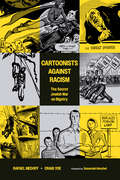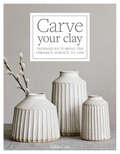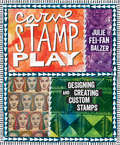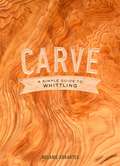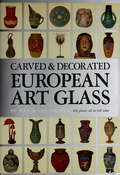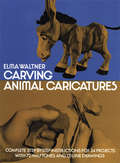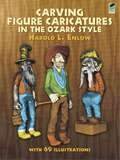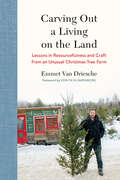- Table View
- List View
Cartographies of Place
by Janine Marchessault Michael DarrochMedia are incorporated into our physical environments more dramatically than ever before - literally opening up new spaces of interactivity and connection that transform the experience of being in the city. Public gatherings and movement, even the capabilities of democratic ideology, have been redefined. Urban Screens, mobile media, new digital mappings, and ambient and pervasive media have all created new ecologies in cities. How do we analyze these new spaces? Recognition of the mutual histories and research programs of urban and media studies is only the beginning. Cartographies of Place develops new vocabularies and methodologies for engaging with the distinctive situations and experiences created by media technologies which are reshaping, augmenting, and expanding urban spaces. The book builds upon the rich traditions and insights of a post-war generation of humanist scholars, media theorists, and urban planners. Authors engage with different historical and contemporary currents in urban studies which share a common concern for media forms, either as research tools or as the means for discerning the expressive nature of city spaces around the world. All of the media considered here are not simply "free floating," but are deeply embedded in the geopolitical, economic, and material contexts in which they are used. Cartographies of Place is exemplary of a new direction in interdisciplinary media scholarship, opening up new ways of studying the complexities of cities and urban media in a global context.
Cartographies of Place: Navigating the Urban (Culture of Cities Series #4)
by Janine Marchessault Michael DarrochMedia are incorporated into our physical environments more dramatically than ever before - literally opening up new spaces of interactivity and connection that transform the experience of being in the city. Public gatherings and movement, even the capabilities of democratic ideology, have been redefined. Urban Screens, mobile media, new digital mappings, and ambient and pervasive media have all created new ecologies in cities. How do we analyze these new spaces? Recognition of the mutual histories and research programs of urban and media studies is only the beginning. Cartographies of Place develops new vocabularies and methodologies for engaging with the distinctive situations and experiences created by media technologies which are reshaping, augmenting, and expanding urban spaces. The book builds upon the rich traditions and insights of a post-war generation of humanist scholars, media theorists, and urban planners. Authors engage with different historical and contemporary currents in urban studies which share a common concern for media forms, either as research tools or as the means for discerning the expressive nature of city spaces around the world. All of the media considered here are not simply "free floating," but are deeply embedded in the geopolitical, economic, and material contexts in which they are used. Cartographies of Place is exemplary of a new direction in interdisciplinary media scholarship, opening up new ways of studying the complexities of cities and urban media in a global context.
Cartographies of Time
by Daniel Rosenberg Anthony GraftonOur critically acclaimed smash hit Cartographies of Time is now available in paperback. In this first comprehensive history of graphic representations of time, authors Daniel Rosenberg and Anthony Grafton have crafted a lively history featuring fanciful characters and unexpected twists and turns. From medieval manuscripts to websites, Cartographies of Time features a wide variety of timelines that in their own unique ways, curving, crossing, branching, defy conventional thinking about the form. A fifty-four-foot-long timeline from 1753 is mounted on a scroll and encased in a protective box. Another timeline uses the different parts of the human body to show the genealogies of Jesus Christ and the rulers of Saxony. Ladders created by missionaries in eighteenth-century Oregon illustrate Bible stories in a vertical format to convert Native Americans. Also included is the April 1912 Marconi North Atlantic Communication chart, which tracked ships, including the Titanic, at points in time rather than by their geographic location, alongside little-known works by famous figures, including a historical chronology by the mapmaker Gerardus Mercator and a chronological board game patented by Mark Twain. Presented in a lavishly illustrated edition, Cartographies of Time is a revelation to anyone interested in the role visual forms have played in our evolving conception of history
Cartoon 360
by Harry HamernikThere's more to great cartooning than drawing a funny face. You need to match that head to a body, give your character expression and attitude, and move him this way and that to tell your story, all while keeping his look consistent from frame to frame. Cartoon 360 covers every angle of drawing fantastic cartoon people, from coming up with fresh ideas for an endless assortment of faces, to bringing your work to a polished, professional finish with inking and coloring.Harry Hamernik's three-dimensional drawing method helps you design fun cartoon characters from head to toe AND draw them again and again, from any angle and in any pose you want.Easy-to-follow demonstrations show the start-to-finish evolution of a variety of character types and poses.Every page is loaded with fun examples and expert secrets, like the amazing power of feature spacing and head height measurements.A power-packed, must-have guide for anyone who wants to draw cartoons, this book contains enough skills and insights to go around ... for characters that pop off the page.
Cartoon Animal Friends: How to Draw Dogs, Cats and Other Pets
by Char ReedFrom the illustrator of the Denver the Guilty Dog series (based on YouTube's real-life Denver the Guilty Dog), comes this fun and easy how-to guide for drawing realistic-looking cartoons and caricatures of your favorite animals--even your own pets! Simple step-by-step instructions show you how to draw dogs, cats, horses and exotic animals--and then which features to exaggerate for whimsical caricatures. Using simple materials such as pens, pencils and paint, you'll learn to enhance your art with targeted lessons in animal anatomy--did you know horses can only bend their knees forward??--and basic breed characteristics. With additional tips from the illustrated Denver himself, you'll soon be creating cartoon animal friends with everything from furry paws and scaly tails to wrinkles, fins and feathers.Inside:15+ step-by-step demonstrations for drawing cartoons of the most popular animals. Learn to draw from reference photos--or even your pets themselves!Chapters devoted to dogs, cats, horses and exotic pets--from hedgehogs and hens to lizards and fish.50+ drawing lessons on breeds and types; animal anatomy; common colors for fur, feathers and scales; funny personality traits, dynamic poses and more.Basic techniques for traditional tools--pencil, paint, ink and charcoal--plus advice for digital painting and drawing programs.How to use simple shapes, line sketches and straightforward color-building methods to easily create animals' heads, bodies, features and unique color markings.Learn which features to enlarge--droopy ears, fluffy tails, big eyes or nosey noses--and which expressions to amplify for fun and funny animal cartoons and caricatures.
Cartoon Animation
by Preston Blair Walter T. FosterThis is the one sourcebook that cartooning and animation enthusiasts have been clamoring about for years! A time-tested classic, this tried-and-true reference is often used as a textbook in cartooning workshops, and beginning and professional cartoonists alike are known to have copies of Cartoon Animation in their libraries. In this comprehensive title, famed animator Preston Blair shares his expertise on how to develop a cartoon character, create dynamic movement, and coordinate dialogue with action. Topics include character development, line of action, dialogue, timing, and, of course, animation! This valuable resource provides all the inspiration and information you need to begin drawing your own animated characters.
Cartoon Cool
by Christopher HartLove that Sponge Bob? Always lurking in Dexter's lab? Wishing for Fairly Odd Parents? Millions of fans watch these shows avidly, often solely for their zingy, stylized look and hip visual jokes. Now there's a drawing book just right for everyone who admires that quirky style: Cartoon Cool. Top-selling author Christopher Hart shows beginning cartoonists, retro fans, and all other hipsters how to get that almost-1950s look in their drawings. His trademark step-by-step drawings and crystal-clear text are sure to make Saturday mornings more creative!
Cartoon County: My Father and His Friends in the Golden Age of Make-Believe
by Cullen MurphyA poignant history of the cartoonists and illustrators from the Connecticut SchoolFor a period of about fifty years, right in the middle of the American Century, many of the the nation’s top comic-strip cartoonists, gag cartoonists, and magazine illustrators lived within a stone’s throw of one another in the southwestern corner of Connecticut—a bit of bohemia in the middle of those men in their gray flannel suits. Cullen Murphy’s father, John Cullen Murphy, drew the wildly popular comic strips Prince Valiant and Big Ben Bolt, and was the heart of this artistic milieu. Comic strips and gag cartoons read by hundreds of millions were created in this tight-knit group—Superman, Beetle Bailey, Snuffy Smith, Rip Kirby, Hagar the Horrible, Hi and Lois, Nancy, Sam & Silo, Amy, The Wizard of Id, The Heart of Juliet Jones, Family Circus, Joe Palooka, and The Lockhorns, among others. Cartoonists and their art were a pop-cultural force in a way that few today remember. Anarchic and deeply creative, the cartoonists were independent spirits whose artistic talents had mainly been forged during service in World War II.Illustrated with never-before-seen photographs, cartoons, and drawings, Cartoon County brings the postwar American era alive, told through the relationship of a son to his father, an extraordinarily talented and generous man who had been trained by Norman Rockwell. Cartoon County gives us a glimpse into a very special community—and of an America that used to be.
Cartoon Cute Animals: How to Draw the Most Irresistible Creatures on the Planet (Christopher Hart's Cartooning)
by Christopher HartLearn the insider secrets professional cartoonists use to turn regular cartoon animals into completely cute characters Warm and fuzzy characters all have that "certain something" that makes them so memorable and darling. But what exactly is it? This sought-after, ultra-cute quality is based on specific techniques that, when applied to character design, result in irresistible cartoon animals. With Cartoon Cute Animals, these are techniques that you can learn, too!Perfect for anyone interested in cartooning, from the aspiring animator looking for how-to instruction to the expert illustrator seeking inspiration, Cartoon Cute Animals covers the broadest possible spectrum of popular species as well as an array of more exotic animals such as the ferret, armadillo, meerkat, and porcupine. Years of experience and expert knowledge have been distilled into one easy-to-follow guide that is full of simple instructions and visual examples to help you create the most adorable cuties ever put to paper!
Cartoon Vision: UPA Animation and Postwar Aesthetics
by Dan BasharaIn Cartoon Vision Dan Bashara examines American animation alongside the modern design boom of the postwar era. Focusing especially on United Productions of America (UPA), a studio whose graphic, abstract style defined the postwar period, Bashara considers animation akin to a laboratory, exploring new models of vision and space alongside theorists and practitioners in other fields. The links—theoretical, historical, and aesthetic—between animators, architects, designers, artists, and filmmakers reveal a specific midcentury modernism that rigorously reimagined the senses. Cartoon Vision invokes the American Bauhaus legacy of László Moholy-Nagy and György Kepes and advocates for animation’s pivotal role in a utopian design project of retraining the public’s vision to better apprehend a rapidly changing modern world.
Cartoon Vision: UPA Animation and Postwar Aesthetics
by Dan BasharaIn Cartoon Vision Dan Bashara examines American animation alongside the modern design boom of the postwar era. Focusing especially on United Productions of America (UPA), a studio whose graphic, abstract style defined the postwar period, Bashara considers animation akin to a laboratory, exploring new models of vision and space alongside theorists and practitioners in other fields. The links—theoretical, historical, and aesthetic—between animators, architects, designers, artists, and filmmakers reveal a specific midcentury modernism that rigorously reimagined the senses. Cartoon Vision invokes the American Bauhaus legacy of László Moholy-Nagy and György Kepes and advocates for animation’s pivotal role in a utopian design project of retraining the public’s vision to better apprehend a rapidly changing modern world.
Cartoonimals
by Harry HamernikIt's a cartooning fun-fur-all!Draw 48 animal characters in short, simple stepsFour paws-up for Cartoonimals! This book makes drawing animal characters super easy and more fun than a barrel of monkeys. It begins with the basics - sketching, drawing facial features, body types, finding the right pose - ultimately, you'll learn how to give your characters the kind of expressions, actions and attitudes that make them much more than lines on a page. Over 45 step-by-step demonstrations help you draw a cool and comical variety of characters, from a guitar-strumming octopus, to a porcupine pirate, to a surfing vulture.Before you know it, you'll be bringing your own original creations to life. With the expert advice in this book, if you can dream it, you can draw it!
Cartooning for the Beginner
by Christopher HartAspiring cartoonists of all ages can begin drawing a repertoire of characters from the moment they follow the wide-ranging yet simplified lessons that fill these instructive pages, written and illustrated by an all-time best-selling artist/teacher.This complete course, covering both comic strip and animation techniques, begins with lessons on basic cartoon body shapes and facial features. Included are helpful comparisons between the real versus the cartoon head, a smile chart, and various ways to draw the most popular and expressive cartoon eyes and mouths. Next come lots of typical body poses, how to draw action lines, slow/fast movement, cartoon hands, fun hair and clothing styles, backgrounds, and cute cartoon pets. Excellent directions also focus on helping beginners to find and develop their own cartoon style.
Cartooning, Caricature and Animation Made Easy
by Chuck ThorndikeWritten by an experienced teacher of cartooning, this volume combines The Secrets of Cartooning, the author's first and more elementary book, and The Art of Cartooning, his follow-up, in which he answered questions raised by readers of his earlier book. Each volume in this double edition is complete in itself as a series of lessons. The first part focuses on such basics as drawing the head, hands, and clothing; creating expressions; conveying motion; and obtaining shading effects. The second section presents a series of lessons in anatomy, followed by advice about drawing caricatures and detailed instructions for creating images for animated features and political cartoons.
Cartooning: Character Design (How to Draw & Paint)
by Sherm CohenLearn the art of cartooning step by step with an Emmy-winning storyboard artist and character designer!This addition to the How to Draw and Paint series comes from accomplished cartoonist Sherm Cohen, renowned for his work on SpongeBob SquarePants and many other film and television productions. It teaches artists the essentials of creating cartoon characters, from using basic shapes and conveying age and mood to adding props and costumes and much more. It also brings the artistic process up to date by touching on the use of computers in cartooning. Featuring step-by-step instructions and a wealth of original images, this book is a must-have resource for any aspiring cartoonist looking to develop their personal style!
Cartooning: Philosophy and Practice
by Ivan BrunettiThe best cartooning is efficient visual storytelling--it is as much a matter of writing as it is of drawing. In this book, noted cartoonist and illustrator Ivan Brunetti presents fifteen distinct lessons on the art of cartooning, guiding his readers through wittily written passages on cartooning terminology, techniques, tools, and theory. Supplemented by Brunetti's own illustrations, prepared specially for this book, these lessons move the reader from spontaneous drawings to single-panel strips and complicated multipage stories. Through simple, creative exercises and assignments, Brunetti offers an unintimidating approach to a complex art form. He looks at the rhythms of storytelling, the challenges of character design, and the formal elements of comics while composing pages in his own iconic style and experimenting with a variety of tools, media, and approaches. By following the author's sophisticated and engaging perspective on the art of cartooning, aspiring cartoonists of all ages will hone their craft, create their personal style, and discover their own visual language.
Cartoonists Against Racism: The Secret Jewish War on Bigotry
by Craig Yoe Rafael MedoffHorrific scenes of anti-Jewish violence in Europe filled the newsreels in American theaters in the 1930s and 1940s.What could be done to make sure it didn&’t happen in America? One Jewish organization hit upon a remarkable idea—to enlist some of America&’s most beloved cartoonists to wage a war on bigotry.Cartoonists Against Racism uncovers the secret campaign to create anti-racist comics and cartoons to flood America&’s newspapers, classrooms, and union halls. Meet the artists and the work that was their ammunition in the battle for America&’s soul.The book showcases impactful anti-racism artwork from the era&’s preeminent cartoonists, including multiple Pulitzer Prize winners Bill Mauldin and Vaughn Shoemaker; New Yorker cartoonists Carl Rose, Mischa Richter, and Frank Hanley; famed antiwar cartoonist Robert Osborn; Dave Berg of Mad magazine; renowned sports cartoonist Willard Mullin; noted labor cartoonist Bernard Seaman; comics artist Mac Raboy (Flash Gordon, Captain Marvel Jr.); and Eric Godal, who escaped from Nazi Germany and became a leading cartoonist in the American press and acclaimed artist Dick Dorgan.
Carve Your Clay: Techniques to Bring the Ceramics Surface to Life
by Hilda CarrApply interesting and inspired surface techniques to your ceramic work through twenty step-by-step projects, including a combed mug, faceted jug, and more.Carve Your Clay takes you through creative techniques that produce amazing, dynamic results, including inlay, piercing, sgraffito, etching, relief carving, wire cutting, and more. Gain new skills as you complete twenty projects featuring author Hilda Carr’s signature style, each with clear step-by-step photography and easy-to-follow instruction to achieve beautiful results.This comprehensive book includes an easy guide on how to create basic forms, as well as glazing and firing techniques. Whether you are new to ceramics or are a more experienced potter looking to explore new surface design techniques, Carve Your Clay will educate and inspire you.“Profusely and effective illustrated throughout, a complete course of thoroughly user friendly and artist inspiring instruction making it an ideal DIY manual.” —Midwest Book Review
Carve, Stamp, Play: Designing and Creating Custom Stamps
by Julie Fei-Fan BalzerTake an exciting journey into printing with custom-carved stamps! In this complete stamp-carving workshop, Julie Fei-Fan Balzer covers every aspect of creating and using rubber stamps, including carving linear and curved designs, alphabets, complex and repeating geometrical shapes, and image transfers. After carving your own unique stamps, you'll also learn: How to combine and layer stamps into original designs. How to design stamps that work together as well as individually. How to create stamps that combine with or enhance other stamps (hand carved or commercial). And how to create complex, layered effects that resemble screen printing. This book also includes simple projects that explore various applications for stamping, including printing on different surfaces such as fabric, leather, paper, and canvas. Find your "authentic" design voice and get carving today!
Carve: A Simple Guide to Whittling
by Melanie AbrantesWhittle a beautiful spoon, comb, pair of dice, and more with this fresh introduction to a folksy craft. Carve modernizes a mindful hobby that people have turned to for generations to help them slow down, relax, and connect with the outdoors. Choose from a dozen projects with bespoke details, all are designed to be useful at home or while camping. And because these objects are small, they require only a few hours and a tool or two to complete. You'll also learn how to choose the right knife and wood, helpful information on techniques and safety, and tips for refining, personalizing and maintaining your piece. Whether you're headed to the woods or just to the porch, this pocket-sized guide will have you carving your own unique designs in no time.From the Hardcover edition.
Carved & Decorated European Art Glass
by Ray Grover Lee GroverRarely has a book been accepted so quickly as a standard reference in the collecting field as Ray and Lee Glover's Art Glass Nouveau, which deals primarily with American aspect of this fascinating subject. Now, in an even more magnificent volume, the present similar detailed coverage of the art glass produced in Europe from 1880 to 1930.Again in full color, 424 plates beautifully portray the accomplishments of the outstanding French and English artist of this period. In very informative text, which is closely related to the illustrations, the Grovers identify the individual techniques of each of these artists.This magnificent book, like its predecessor, is a definitive work permanently available for reference. It, too, is a must for everyone requiring advanced as well as basic knowledge in the field of art glass.
Carved & Decorated European Art Glass
by Ray Grover Lee GroverRarely has a book been accepted so quickly as a standard reference in the collecting field as Ray and Lee Glover's Art Glass Nouveau, which deals primarily with American aspect of this fascinating subject. Now, in an even more magnificent volume, the present similar detailed coverage of the art glass produced in Europe from 1880 to 1930.Again in full color, 424 plates beautifully portray the accomplishments of the outstanding French and English artist of this period. In very informative text, which is closely related to the illustrations, the Grovers identify the individual techniques of each of these artists.This magnificent book, like its predecessor, is a definitive work permanently available for reference. It, too, is a must for everyone requiring advanced as well as basic knowledge in the field of art glass.
Carving Animal Caricatures
by Elma WaltnerElma Waltner, Crafts Designer from Hurley, South Dakota, has put together a series of specific instructions that will enable even the amateur, using the simplest tools and materials, to progress easily from raw wood to an interesting hand-carved animal. All that's needed is a small block of two-inch wood -- redwood, white pine, sugar pine, western pine, basswood, cottonwood, or any other soft wood -- and a simple pocket or carver's knife. Inexpensive watercolors or enamels, shellac, and varnish are perfect for decoration and finishing.Each step in the carving is made absolutely clear through photographs and angle sketches. There are profile patterns (to be traced on the block) for all of the 24 projects, ranging from Bolivar Bull through Casper Camel to Sammy Stegosaurus. Horatio Horse, Gulliver Goat, and Esmerelda Elephant serve as teaching pieces, with complete instructions from start to finish for each. Once these have been mastered, the same methods are easily applied to the rest of the projects, and special steps in the carving of these are again shown in photographs.The poses and animals represented here are only a beginning in animal caricature, and the hobbyist will soon find himself developing other animals and other poses of these familiar friends to add to his wooden menagerie. They will find in these and in their own projects an almost inexhaustible source of gentle relaxation and delight.
Carving Figure Caricatures in the Ozark Style
by Harold R. EnlowWood carving in the Ozark style is easy and fun when you follow professional carver Harold Enlow's directions. Using figures he has carved for his own collection in Dogpatch, Arkansas, he gives instructions and illustrations that cover every angle of carving figure caricatures.He tells you how to go about selecting and preparing the wood, selecting the proper tools, sharpening the tools, using a mallet and band saw, roughing out a figure from a block, carving a head and face, and finishing your carvings. Then he presents explicit instructions for ten projects: a Missouri mule, a mountaineer, a hobo, a cowboy, a hill woman, Rufus and Sadie, Bootsie the cow, a banjo player, "Ozark Trail's End," and "Revenooers." Each project is illustrated in diagram form (front and usually profile) to make it easy to draw on the wood, and there are photographs of each completed project and some in intermediate stages. The general instructions are also illustrated copiously, and there are photographs of other completed carvings from the author's collection -- a total of 22 drawings and 47 photographs in all.Whether you are an accomplished carver or just beginning, you will find these caricatures a delightful group and very easy to do. The projects are arranged in order of difficulty, and by the time you get to the last one, you will be ready to do your own designs and carve your own caricatures."One of the better (books) around on wood-carving." -- Indianapolis News.
Carving Out a Living on the Land: Lessons in Resourcefulness and Craft from an Unusual Christmas Tree Farm
by Emmet Van Driesche"A thorough and generous guide to shaping your world not only to your own happiness, but the world&’s as well.&”—John Hodgman, host of Judge John Hodgman; author of VacationlandCarving Out a Living on the Land tells the story of how author Emmet Van Driesche navigated changing life circumstances, took advantage of unexpected opportunities, and leveraged new and old skills to piece together an economically viable living on marginal farmland, while at the same time respecting the land&’s complex ecological relationships. Van Driesche&’s adventure began when he recognized that he could do much more with his land than simply tend rows of perfectly sheared Christmas trees.From spoon carving to scything, coppicing to wreath-making, Carving Out a Living on the Land proves that you don&’t need acres of expensive bottomland to start your land-based venture, but rather the creativity and vision to see what might be done with that rocky section or ditch or patch of trees too small to log. You can lease instead of buy; build flexible, temporary structures rather than sink money into permanent ones; and take over an existing operation rather than start from scratch. What matters are your unique circumstances, talents, and interests, which when combined with what the land is capable of producing, can create a fulfilling and meaningful farming life.
